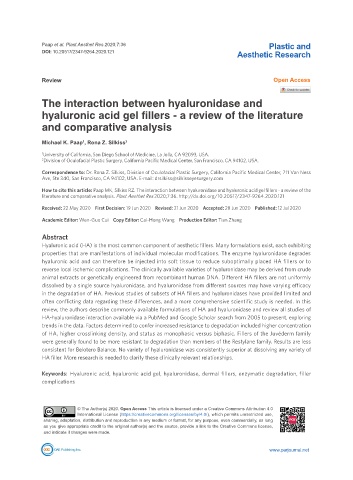Page 391 - Read Online
P. 391
Paap et al. Plast Aesthet Res 2020;7:36 Plastic and
DOI: 10.20517/2347-9264.2020.121 Aesthetic Research
Review Open Access
The interaction between hyaluronidase and
hyaluronic acid gel fillers - a review of the literature
and comparative analysis
Michael K. Paap , Rona Z. Silkiss 2
1
1 University of California, San Diego School of Medicine, La Jolla, CA 92093, USA.
2 Division of Oculofacial Plastic Surgery, California Pacific Medical Center, San Francisco, CA 94102, USA.
Correspondence to: Dr. Rona Z. Silkiss, Division of Oculofacial Plastic Surgery, California Pacific Medical Center, 711 Van Ness
Ave, Ste 340, San Francisco, CA 94102, USA. E-mail: drsilkiss@silkisseyesurgery.com
How to cite this article: Paap MK, Silkiss RZ. The interaction between hyaluronidase and hyaluronic acid gel fillers - a review of the
literature and comparative analysis. Plast Aesthet Res 2020;7:36. http://dx.doi.org/10.20517/2347-9264.2020.121
Received: 22 May 2020 First Decision: 19 Jun 2020 Revised: 21 Jun 2020 Accepted: 28 Jun 2020 Published: 12 Jul 2020
Academic Editor: Wen-Guo Cui Copy Editor: Cai-Hong Wang Production Editor: Tian Zhang
Abstract
Hyaluronic acid (HA) is the most common component of aesthetic fillers. Many formulations exist, each exhibiting
properties that are manifestations of individual molecular modifications. The enzyme hyaluronidase degrades
hyaluronic acid and can therefore be injected into soft tissue to reduce suboptimally placed HA fillers or to
reverse local ischemic complications. The clinically available varieties of hyaluronidase may be derived from crude
animal extracts or genetically engineered from recombinant human DNA. Different HA fillers are not uniformly
dissolved by a single source hyaluronidase, and hyaluronidase from different sources may have varying efficacy
in the degradation of HA. Previous studies of subsets of HA fillers and hyaluronidases have provided limited and
often conflicting data regarding these differences, and a more comprehensive scientific study is needed. In this
review, the authors describe commonly available formulations of HA and hyaluronidase and review all studies of
HA-hyaluronidase interaction available via a PubMed and Google Scholar search from 2005 to present, exploring
trends in the data. Factors determined to confer increased resistance to degradation included higher concentration
of HA, higher crosslinking density, and status as monophasic versus biphasic. Fillers of the Juvéderm family
were generally found to be more resistant to degradation than members of the Restylane family. Results are less
consistent for Belotero Balance. No variety of hyaluronidase was consistently superior at dissolving any variety of
HA filler. More research is needed to clarify these clinically relevant relationships.
Keywords: Hyaluronic acid, hyaluronic acid gel, hyaluronidase, dermal fillers, enzymatic degradation, filler
complications
© The Author(s) 2020. Open Access This article is licensed under a Creative Commons Attribution 4.0
International License (https://creativecommons.org/licenses/by/4.0/), which permits unrestricted use,
sharing, adaptation, distribution and reproduction in any medium or format, for any purpose, even commercially, as long
as you give appropriate credit to the original author(s) and the source, provide a link to the Creative Commons license,
and indicate if changes were made.
www.parjournal.net

